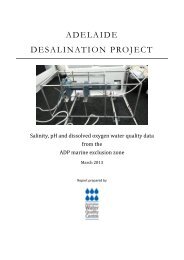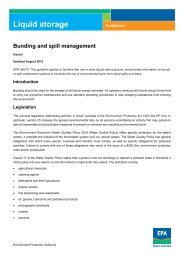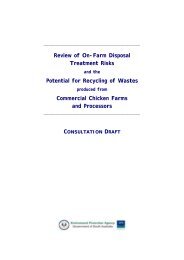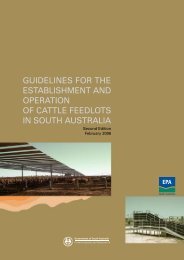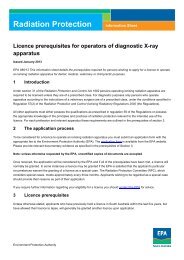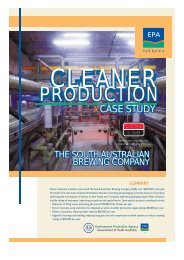2 Renmark to border LAP area assessment - EPA - Sa.gov.au
2 Renmark to border LAP area assessment - EPA - Sa.gov.au
2 Renmark to border LAP area assessment - EPA - Sa.gov.au
You also want an ePaper? Increase the reach of your titles
YUMPU automatically turns print PDFs into web optimized ePapers that Google loves.
River Murray and Lower Lakes catchment risk <strong>assessment</strong> for water quality: Results and management options<br />
saline and connected <strong>to</strong> the river) and creek (Big and Little Toolunka creeks) discharges. Run of the river<br />
and other salinity modelling studies have noted significant saline groundwater inputs in the RW <strong>LAP</strong><br />
region between Waikerie and Morgan supporting this general level of risk. Horticultural land use in these<br />
<strong>area</strong>s is predominantly citrus and grapes that employ drip and/or canopy irrigation (Croucher 2005).<br />
Large irrigated <strong>area</strong>s have increased saline groundwater flows <strong>to</strong> the river and floodplain by creating an<br />
‘irrigation mound’ (elevated water head under irrigation <strong>area</strong>s). Irrigation displaces approximately 950<br />
<strong>to</strong>nnes of salt per day within the RW <strong>LAP</strong> <strong>area</strong>: 210 <strong>to</strong>nnes enters the river and the rest is s<strong>to</strong>red on the<br />
floodplain (RW <strong>LAP</strong> 1999). There is some uncertainty about the ecological impact of salinity from saline<br />
discharges <strong>to</strong> the river, as salinity levels have his<strong>to</strong>rically been variable (MDBC 1988).<br />
Several management schemes are in place or planned <strong>to</strong> manage salt in the region, including from the<br />
high risks identified above. SA Water operates two large salt interception schemes located at Waikerie<br />
and Woolpunda which work by capturing saline groundwater using deep bores near the river and pumping<br />
it away <strong>to</strong> a specially created disposal basin at S<strong>to</strong>ckyard Plain (15 km south-west of Waikerie). Before<br />
these schemes were implemented, the River Murray was carrying up <strong>to</strong> 250 <strong>to</strong>nnes per day of salt past<br />
Woolpunda and 100 <strong>to</strong>nnes a day past Waikerie. Recent surveys show these salinity levels have decreased<br />
<strong>to</strong> less than 10 <strong>to</strong>nnes a day in each <strong>area</strong>7 . Irrigation drainage that used <strong>to</strong> enter Ramco lagoon is also<br />
now being diverted <strong>to</strong> the Waikerie scheme and a management plan is in place for this lagoon. A Hart<br />
lagoon wetland management plan has been developed <strong>to</strong> manage the wetting and drying cycles of the<br />
lagoon <strong>to</strong> maintain and enhance native flora and f<strong>au</strong>na communities, and reduce the impact of salinity<br />
on the wetland. Irrigation practices have generally improved in the Riverland <strong>area</strong> and flood irrigation is<br />
now rare. An on-ground water efficiency project is currently providing irriga<strong>to</strong>rs with information and<br />
increasing awareness of best-practice land management. While irrigation technology has been well<br />
adopted throughout the region, this project aims <strong>to</strong> provide high-level understanding of current bestpractice<br />
techniques. The Riverland revegetation incentive scheme has also been in operation, in which<br />
groups or individual landholders are encouraged <strong>to</strong> rehabilitate wetlands and other native vegetation<br />
sites within their property.<br />
The non-permanently connected wetlands were rated as a moderate risk during large rainfall events or<br />
floods when salt, previously trapped in the floodplain and non-flowing creeks, is mobilised and flushed<br />
in<strong>to</strong> the river proper. The risk may be higher during the initial ‘first flush’ of such an event; further<br />
research is needed <strong>to</strong> refine the risk <strong>assessment</strong>. The RW <strong>LAP</strong> <strong>area</strong> is part of the combined Riverland<br />
network, where several small-scale projects are in place <strong>to</strong> moni<strong>to</strong>r discharges from lagoons and<br />
wetlands within the region.<br />
Nutrients<br />
Several large horticulture <strong>area</strong>s noted above as high risks for salinity also received a high risk ranking for<br />
leakage of nutrients (in particular nitrate) through groundwater <strong>to</strong> the river, based on their large-scale<br />
saline groundwater inputs. Elevated levels have been reported under irrigation <strong>area</strong>s in other <strong>area</strong>s of<br />
South Australia (eg Northern Adelaide Plains, <strong>EPA</strong> 2003a). Some lagoons (Hart and Ramco) that receive<br />
irrigation drainage and are permanently connected <strong>to</strong> the river also received a high-risk ranking.<br />
7 See <br />
90




